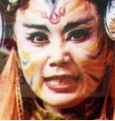| The tunes
of Taiwanese Opera started from folk ballads, gua-a, evolved
into different types of melodies, such as chi-zi diao, da
diao, bai sz, and tza-liam-a. The word, diao means tunes or
melodies in both Mandarin and Taiwanese. Taiwanese Opera enriched
its own music capacity by absorbing tunes or ballads from
other types of theatric forms. For example, chi-zi diao, dou
ma diao, tza-liam-a, da diao, bei sz, liou shu diao, man tou,
verse chant, tsuo chin diao, wu jing gu, chi shi diao, yin
diao, juang yuan diao, jiang hu diao, new north tune, jin
dieh zai... etc. There is no fixed patterns for the application
of these different tunes. Usually, they are inserted into
the drama to cooperate with the plot. Among these tunes, chi-zi
diao and dou ma diao are two most frequently applied melodies
in Taiwanese Opera.
A chi-zi diao is made of four lines. Each line has seven syllables.
Chi-zi diao preserves the unique feature of traditional Taiwanese
ballads. Chi-zi diao has a strong flavor of Taiwanese grassroots,
and it is vastly used in Taiwanese Opera. If you want to sing
Taiwanese Opera, the first step is to master chi-zi diao.
Without chi-zi diao, Taiwanese Opera could never be called
Taiwanese Opera.
The next most widely used tune in Taiwanese Opera is dou ma
diao. Taiwanese Opera can’t be performed without dou ma diao.
The difference between dou ma diao and chi zi diao is that
unlike the fixed seven syllables of chi zi diao, dou ma diao
is more impromptu. It can include fourteen syllables, ten
syllables, or eight syllables. If the actor forgets her line
on the stage, she could still improvise with dou ma diao.
The tunes of Taiwanese Opera is accompanied by hexagon-shaped
Chinese mandolin and da guang sian(a large, two-stringed
Chinese mandolin). Actors may sing or chant with the tune.
The lyrics of Taiwanese Opera in early times were abundant,
comprehensive, lively and delicate. Lyrics help actors enact
their characters and express the idea of morality. The melodies
are quite flexible in variations of tempo and lyrics. Different
tempos symbolize different emotions or feelings. Almost no
two actors can sing the same tune in exact same ways because
everyone improvises with their own creativity.
We have obtained twelve classic tunes of Taiwanese Opera from
the Ming Hwa Yuan. The lyrics of the following sample tunes
are written by Mr. Chen Sheng-guo, the director of the Ming
Hwa Yuan. These are the voice clips from the Ming Hwa Yuan’s
classic large dramas. Let’s hear it!
|



